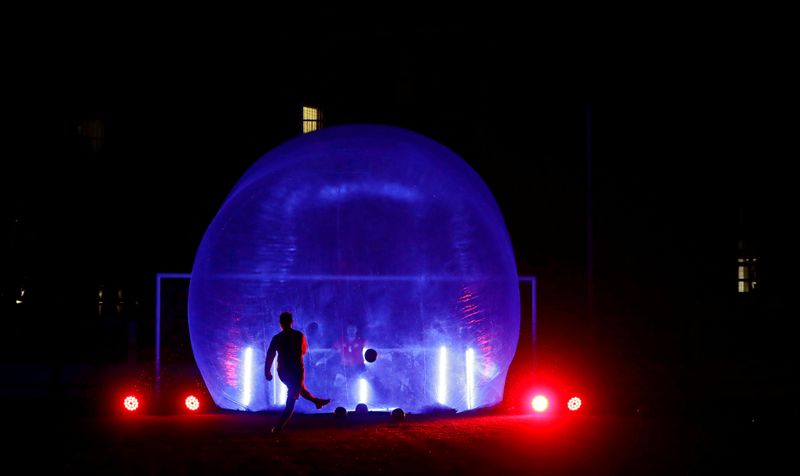PARIS (Reuters) – As Europeans brace for a grim winter with the threat of rising COVID-19 infections, minimal numbers of flu cases recorded so far point to a possible silver lining.
Data available for Europe since the beginning of October, when flu case numbers usually start to ramp up, mirror shallow figures seen in the Southern Hemisphere earlier this year and in the United States where the flu season has also just begun.
Some doctors say a combination of lockdowns, mask wearing and handwashing appear to have hampered transmission of the flu, while warning that the data should be treated with caution because the peak of the season is weeks or even months away.
According to Flu News Europe, a joint monitoring platform of the European Centre for Disease Prevention and Control and the World Health Organization which collects samples in 54 European regions, only one person was diagnosed with flu out of 4,433 sentinel tests during Sept. 28-Nov. 22.
This sentinel-source data — case figures collated by national health authorities based on samples taken by a range of community doctors — translates into a positivity rate of 0.02%. That rate is well below a 10% threshold that the WHO considers to be “epidemic” when it comes to flu.
At the same time last year, this percentage stood at 15%.
U.S. public health laboratories and clinical laboratories have reported fewer than 500 total cases and no deaths since Sept. 27, according to the U.S. Centers for Disease Control and Prevention.
While scientists caution that the coronavirus pandemic has constrained testing for flu, the low European sentinel rate so far will provide some relief to governments and health authorities, which had feared a potentially lethal “twindemic” of COVID-19 and flu overwhelming hospitals during the winter.
“In any given typical year, we should be witnessing hundreds of influenza cases at this stage in Europe and beyond,” Bruno Lina, a senior virologist with Hospices Civils de Lyon, which runs 13 hospitals in France’s third-largest city, told Reuters.
“Steps adopted to prevent transmission of COVID-19 are very efficient against influenza and other respiratory viruses.”
He and two other experts also cited the possible impact of “viral interference”, also known as superinfection resistance, — a mechanism by which being exposed to a virus triggers an immune response that is deadly to other pathogens.
“In this instance, this means the coronavirus is currently filling a space that makes it very difficult, if not impossible, for other respiratory viruses such as influenza to coexist with it,” he said.
Seasonal flu viruses cause between 4 and 50 million infections each year and up to 70,000 Europeans die annually of causes linked to flu, particularly among older adults and at-risk groups.
Deaths in Europe attributed to COVID-19 have exceeded 370,000 so far this year.
UNCERTAINTIES
Several scientists cautioned that any success in curbing COVID contamination could also reduce the viral interference that is keeping flu at bay. Flu infections usually peak in the first weeks of the year in the Northern Hemisphere. This year in Europe it was in February.
As many governments ease restrictions to allow festive gatherings for Christmas and the new year, health authorities fear tackling the pandemic could be made more difficult.
Another uncertainty lies in flu vaccine uptake rates. Experts say rates vary greatly across the European region despite government campaigns urging citizens this year to get a flu shot as early as possible.
Low numbers of recorded infections so far could discourage those not yet vaccinated from getting a shot, said Edward Hill, a research fellow with University of Warwick.
Low influenza numbers also pose a challenge for the vaccine manufacturers as they prepare for the 2021/22 season.
Each year in late February, the WHO recommends the strains manufacturers will use for the vaccines during the following winter season in the Northern Hemisphere.
Top drugmakers such as GlaxoSmithKline, Sanofi, Abbott and Seqirus boosted supplies to the region by an average of 30% this year in anticipation of higher demand, although supplies to some countries still fell short.
“Given that the prevalence of globally circulating flu is incredibly low right now, the WHO may not have the thousands of influenza positive samples it usually relies on to make strain selection decisions,” Matthew Downham, an expert with the Vaccines Europe influenza working group of the EFPIA, said.
“The WHO may have to marginally postpone its strain selection recommendation to March for one or more strains. This, in turn, may pose extra challenges to manufacturers.”
The WHO did not immediately respond to a request for comment.
(Additional reporting by Kate Kelland in London; Caroline Humer in New York; editing by Josephine Mason and Philippa Fletcher)
























